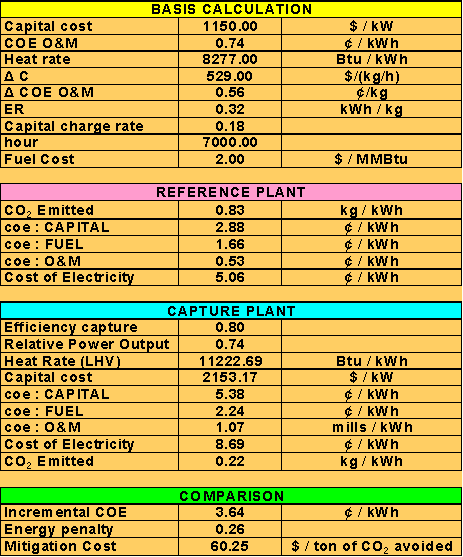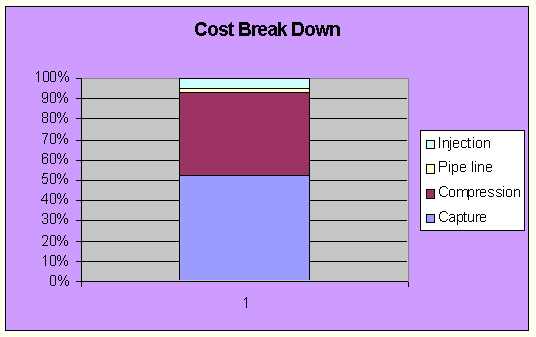 | The Capture and Sequestration of Carbon Dioxide |
|
 Case Study
Case Study

 The Economics
The Economics
ECONOMIC ANALYSIS FOR SEQUESTRATION IN SALINE FORMATION
Calculate capture cost using Cost Model Analysis
Performance of the plant
- PC power plant using Flue Gas Desulfurization (FGD)
- Power without CO2 capture : 500 MW
- Power with CO2 capture : 362 MW
- CO2 released without capture : 0.828 kg / kWh

Compression & Pipe Line
Cost Break Down
- Compressor : 3 parallel 13 MW, 4 stage centrifugal : US $ 18,400,000/ each, efficiency 40 %, using fuel as power
- Dehydration plant : US$ 5.1 M / ton CO2
- Pipe line : US$ 710 / m
- Maintenance cost : 4 % of material cost
- Labor : 4 maintenance workers, 5 operators, 2 inspectors, 1 QA, 1 supervisor
Drilling Cost Break Down
- Drilling : US$ 645 / m
- Electricity : US$ 0.065 / kWh
- Preliminary site screening : US$ 330,000
- Candidate evaluation : US$ 1,355,000
- Labor : 2 maintenance workers, 11 operators, 1 QA, 1 supervisor
- Analysis process : US$ 200 / analysis
- USDW sample (20 wells) : US$ 300 / analysis
Environmental
- Applying climate change levy 0.05 p/tonne CO2
® carbon sequestration will decrease cost of tax 27.6%
(present condition)
- Applying carbon tax £ 40 / tonne CO2
® carbon sequestration will decrease cost of tax 80.81%
RESULT OF CALCULATION
- Cost of Capture : 43.1 M US$ / year (52.46 %)
- Cost of Compression : 33.39 M US$ / year (40.64 %)
- Cost of pipe line : 1.79 M US$ / year (2.18 %)
- Cost of injection : 3.88 M US$ / year (4.72 %)
Total cost :82.16 M US$ / year
CO2 captured : 0.926 kg / kWh
CO2 avoided : 0.61 kg / kWh

Renewables and other low carbon options
IThe practicable resource from renewables options by 2025 is large. Allowing for technological advance, but before additional systems costs around half to two-thirds of projected electricity demand could be met by renewables with electricity costing under 5p/kWh. Delivery will be substantially reliant on wind (on and offshore) and, to a lesser extent, energy crops. The key issues for renewables include the achievement of technological advances to bring costs down and the management and cost of the security attached to intermittent sources of generation.
Onshore wind has a large potential with generation of 50TWh/year by 2025 costing around 2-2.5p/kWh. This could remain competitive even if the additional system costs of intermittent supply, an area requiring further work, rise towards 0.4p/kWh (a level of penalty which may not be reached until intermittent sources make up well over 20% of generation).
Offshore wind could offer the greatest potential for renewable generation. Little has been developed in the UK so far, but advances in installation methods and demonstration plants could prove the technology, reduce costs and increase deployment. By 2020-25, the cost could be down to 2-3p/kWh and 100TWh/year (over one-quarter of the UK’s generation needs) could be provided. Again, further systems costs will need to be factored in.
Municipal solid waste and landfill gas could be competitive (cost around 1.5-2.7p/kWh), but the scale of resource is likely to be relatively small – around 3-4% of total generation.
Energy crops and other woody biomass could be a significant resource at around 10% of generation. But this is at a slightly higher cost than wind (and also above generation from gas), at around 3-4.5p/kWh.
Tidal stream has modest technical potential but might be available at a cost of around 3.4-6p/kWh. Other options such as active solar and wave power are unlikely to be available at an economically acceptable cost.
Nuclear currently provides the bulk of carbon-free electricity generation in the UK and just over 20% of all generation. If low construction costs for the new technologies were confirmed (which might require series construction and high availabilities) then it is possible to see new nuclear generation competing with other generation at reasonable levels of carbon value at costs of 2.6-4p/kWh.
In terms of overall costs to the economy, moving to a carbon-free generation system by 2050 could cost between -0.1% and +0.2% of GDP (with GDP having grown threefold by then).



